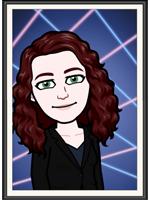

Supercalifragilistic Lack of Accessibility is Pedagogically Atrocious |
Listen and learn : Ed talk
Jenna Ashley Chrystal Trapani
Accessibility isn't about disability - it's about ability and making things easier for all students. There are three main accessibility standards: color contrast, closed captioning/subtitles, and accessible PDFs. The reality is, classes will never go back to being entirely f2f synchronous; faculty must embrace digital accessibility in their online courses.
| Audience: | Curriculum/district specialists, Professional developers, Teachers |
| Skill level: | Beginner |
| Attendee devices: | Devices useful |
| Attendee device specification: | Smartphone: Android, iOS, Windows Laptop: Chromebook, Mac, PC Tablet: Android, iOS, Windows |
| Participant accounts, software and other materials: | Google Account recommended |
| Topic: | Equity and inclusion |
| ISTE Standards: | For Coaches: Change Agent
Equity and Citizenship Advocate
|
| Related exhibitors: | Mote |
Purpose
The purpose of this presentation is to bring better awareness and understanding to individuals involved in student success to the importance of digital accessibility.
Objectives
1. Review who is impacted by digital accessibility
2. Recognize basic digital accessibility
a. Recognize what contrast is and how to check for compliance
b. Recognize when closed captioning and/or transcriptions must be applied
c. Review when using PDFs is appropriate in an educational setting and how to apply accessibility standards
3. Discover best practices for transitioning inaccessible course content to accessible course content
4. Acquire accessibility resources
https://docs.google.com/document/d/1lz_ALituBM_73DW8_3IzS8pxbSdv0QagERgOvLp0QWs/edit?usp=sharing
Accessibility Resources (Google Doc)- https://docs.google.com/document/d/1zPV36KfJk937q29dF2bwxf3BJlUJ-q1TyhWKxJnFRYo/edit?usp=sharing

Google Certified Trainer, Google Certified Coach, Canvas Certified Educator. Instructional Technology Specialist at Old Dominion University, former secondary inclusion mathematics teacher. Accessibility Advocate, School Leader, Doctoral student in educational leadership with a research emphasis on digital accessibility. Disabled (Hearing impaired, ADHD/Autistic, physically disabled) For More: https://bit.ly/Jenna_Ashley

Chrystal Trapani is an Instructional Technologist with the Center for Learning and Teaching and an adjunct instructor in the Department of English at Old Dominion University. Chrystal blends her experience working with first-generation and non-traditional students, curriculum development, creating interactive and accessible online course content, digital accessibility, and training faculty in order to help them achieve positive student outcomes and success. In working with faculty, she helps her colleagues gain strong, working knowledge of how to make course content successful for students of all learning abilities.
Digital Learning Coaches: How to Build Capacity and Leverage Impact
Down the Rabbit Hole: Personalized PD
Leadership Perceptions on Building Culture and Impact With ISTE Certified Educators